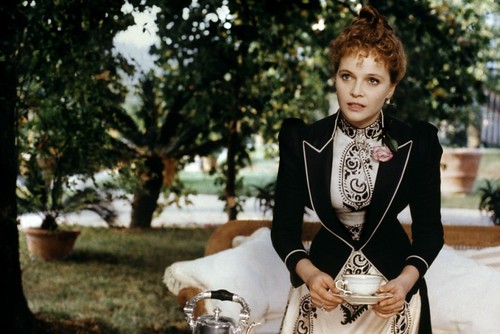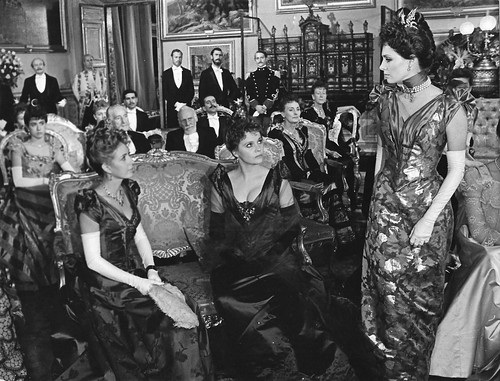
Romanian postcard by Casa Filmului Acin, no. C.P.C.S. C. da 43.142.
Dr. Goldfoot and the girl bombs
Laura Antonelli was born Laura Antonaz in 1941 in Pola (now Pula, Croatia), which at the time was the capital of the Italian province of Istria. After the war, her parents fled what was then Yugoslavia. The family lived in Italian refugee camps in Genoa and Venice before they settled in Naples. She had a childhood interest in education, and as a teenager, she became proficient at gymnastics. Setting aside ambitions to make a career in mathematics, she graduated as a gymnastics instructor.
She moved to Rome, where she became a secondary school gym teacher. She met people in the entertainment industry, who helped her find modelling jobs. Antonelli's earliest engagements included Italian advertisements for soft drinks and bedsheets and appearances on the TV show Carosello (1957-1977). In 1965, she made her first, uncredited film appearance in Le sedicenni/16-Year-Olds (Luigi Petrini, 1965).
Her 'American' debut came was in Dr. Goldfoot and the Girl Bombs (Mario Bava, 1966), an Italian-American co-production starring Vincent Price. Two versions of the film were made, an Italian and an American version. The American version was re-written, re-scored and re-edited without the participation of Mario Bava. The film was not particularly successful. According to Wikipedia, it is considered by many critics to be director Bava's worst film yet it was his commercially most successful film in Italy. Vincent Price's Goldfoot is the only character who appears in both versions. American distributor Samuel Z. Arkoff said the film's commercial reception was hurt by the refusal of Laura Antonelli to take her clothes off. Arkoff claimed she was originally willing to, but then his nephew, Ted Rusoff, who was sent to supervise the film, developed a crush on her and persuaded her not to do it.
Other roles for Antonelli soon followed in a number of sexy films such as the erotic drama La Rivoluzione Sessuale/The Sexual Revolution (Riccardo Ghione, 1968) with a screenplay co-written by Dario Argento, Venere in pelliccia/Venus in Furs (Massimo Dallamano, 1969) and Il merlo maschio/The Male Blackbird (Pasquale Festa Campanile, 1971) about a frustrated cello player (Lando Buzzanca), who exposes his wife (Antonelli) in a reworking of the renowned photograph by Man Ray.
In 1971, Laura Antonelli appeared opposite Jean-Paul Belmondo in the successful French comedy Les Mariés de l'an Deux/The Married Couple of the Year Two (Jean-Paul Rappeneau, 1971) and the two stars also privately had a turbulent, headline-grabbing, nine-year affair. She did more French films with Belmondo, such as the black comedy and love triangle Dr. Popaul/High Heels (Claude Chabrol, 1972) with Mia Farrow. Antonelli had previously divorced Italian publisher Enrico Piacentini.

Italian postcard by Playboy edizioni Italiana, no. 2, 1982. Photo: Roberto Rocchi.

Laura Antonelli in L'innocente/The Innocent (1976). Photo: collection Véronique@Flickr.
Sexual awakening
In 1973, Laura Antonelli had her breakthrough with the comedy Malizia/Malicious (Salvatore Samperi, 1973) for which she won the Italian National Syndicate of Film Journalists Award, Nastro d'Argento in 1974. The film is about the parallel desire of a widower and his three teenage sons for their new housekeeper. The film challenged sexual taboos by presenting and mixing such themes as a 14 years old boy (Alessandro Momo) who blackmails the housekeeper into eventually tolerating his increasingly aggressive physical sexual harassment. It was the most popular Italian film in Italy in 1973. In the same year, she also had a huge commercial success with the anthology comedy Sessomatto/How Funny Can Sex Be? (Dino Risi, 1973), in which she plays an unchaste nun clad in white vestments and stockings opposite Giancarlo Giannini. From then on, she played leading roles in some major films.
In Luchino Visconti's last film, L'innocente/The Innocent (1976), she played the wife of Giancarlo Giannini. Based on a novel by Gabriele D'Annunzio, the film is set among the aristocracy of 19th-century Italy. Wealthy Tullio (Giannini) thinks nothing of squiring his mistress (Jennifer O'Neill) in full view of his friends and the public. But when Giannini's cast-off wife (Antonelli) begins an affair with a young novelist, it is too much for the philandering aristocrat. Wheeler Winston Dixon reviews the film at AllMovie: "Visconti's merciless mise-en-scène dissects his characters as if they were insects under a microscope; as he grew older as a director, Visconti's seemingly natural antipathy to human weakness became almost his signature style. The film is operatic, grand, and yet deeply intimate and personal, making it simultaneously one of Visconti's most accomplished and most disheartening films."
In the romance Mogliamante/Wifemistress (Marco Vicario, 1977) with Marcello Mastroianni, she played a repressed wife experiencing a sexual awakening. Later she appeared in Passione d'Amore/Passion of Love (Ettore Scola, 1981) with Bernard Giraudeau. She also played in two comedies loosely based on Molière's plays, Il malato immaginario/Hypochondriac) (1979) and L'avaro/The Miser (1990), both directed by Tonino Cervi and starring Alberto Sordi. Antonelli's final role was in the sequel Malizia 2000/Malice 2000 (Salvatore Samperi, 1991).
In 1991, a large amount of cocaine was found during a police raid on Antonelli's home. She was subsequently convicted of possession and dealing and sentenced to house arrest. The desire to see Laura Antonelli again on the big screen beyond her legal misadventures was so strong that it led to the production of Malicia 2000 (1991), the sequel to the film that had made her world-famous almost twenty years earlier. The film was again directed by Salvatore Samperi and produced by Silvio Clementelli, but the magic no longer worked and the film was a box-office flop. The repercussions of this failure, as well as the ongoing legal imbroglio, led the actress to abandon her career.
During the preparation of Malicia 2000, Laura Antonelli underwent a plastic surgeon's treatment who injected collagen into her face to hide some wrinkles, but an allergy caused an unexpected and dramatic effect that left her with more or less irreversible consequences. She pitted a civil lawsuit against the surgeon. After thirteen years of proceedings, the court in Rome rejected her claim for damages, ruling that her skin problems were due to an allergic reaction called angioedema. Charges were dropped against the surgeon, as well as the producer and director, who were also sued for forcing her to undergo the treatment. The excessive slowness of the justice system caused Antonelli to suffer deeply and she was admitted to the specialised hospital of Civitavecchia, which led her lawyers to sue the Ministry of Justice and demand financial compensation from the Italian State for the damage suffered. In 2006 the Italian court of appeals finally ruled in the favour of Antonelli and ordered the state to pay the former actress 108,000 euros. Antonelli then lived in seclusion in Ladispoli in modest housing provided by Ladispoli social services in 2009, where she died in 2015, aged 73, from a heart attack. She is buried in the city cemetery.

Italian press photo. Photo by Mario Tursi. Marie Dubois, Laura Antonelli and Jennifer O'Neill in L'innocente/The Innocent (Luchino Visconti, 1976). Setting: Palazzo Colonna, Rome.
Sources: Nick Vivarelli (Variety), Wheeler Winston Dixon (AllMovie), Hal Erickson (AllMovie), Wikipedia and IMDb.
This post was last updated on 18 April 2023.
No comments:
Post a Comment